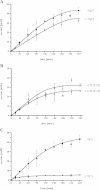A genome-guided analysis of energy conservation in the thermophilic, cytochrome-free acetogenic bacterium Thermoanaerobacter kivui
- PMID: 25523312
- PMCID: PMC4320612
- DOI: 10.1186/1471-2164-15-1139
A genome-guided analysis of energy conservation in the thermophilic, cytochrome-free acetogenic bacterium Thermoanaerobacter kivui
Abstract
Background: Acetogenic bacteria are able to use CO2 as terminal electron acceptor of an anaerobic respiration, thereby producing acetate with electrons coming from H2. Due to this feature, acetogens came into focus as platforms to produce biocommodities from waste gases such as H2+CO2 and/or CO. A prerequisite for metabolic engineering is a detailed understanding of the mechanisms of ATP synthesis and electron-transfer reactions to ensure redox homeostasis. Acetogenesis involves the reduction of CO2 to acetate via soluble enzymes and is coupled to energy conservation by a chemiosmotic mechanism. The membrane-bound module, acting as an ion pump, was of special interest for decades and recently, an Rnf complex was shown to couple electron flow from reduced ferredoxin to NAD+ with the export of Na+ in Acetobacterium woodii. However, not all acetogens have rnf genes in their genome. In order to gain further insights into energy conservation of non-Rnf-containing, thermophilic acetogens, we sequenced the genome of Thermoanaerobacter kivui.
Results: The genome of Thermoanaerobacter kivui comprises 2.9 Mbp with a G+C content of 35% and 2,378 protein encoding orfs. Neither autotrophic growth nor acetate formation from H2+CO2 was dependent on Na+ and acetate formation was inhibited by a protonophore, indicating that H+ is used as coupling ion for primary bioenergetics. This is consistent with the finding that the c subunit of the F1FO ATP synthase does not have the conserved Na+ binding motif. A search for potential H+-translocating, membrane-bound protein complexes revealed genes potentially encoding two different proton-reducing, energy-conserving hydrogenases (Ech).
Conclusions: The thermophilic acetogen T. kivui does not use Na+ but H+ for chemiosmotic ATP synthesis. It does not contain cytochromes and the electrochemical proton gradient is most likely established by an energy-conserving hydrogenase (Ech). Its thermophilic nature and the efficient conversion of H2+CO2 make T. kivui an interesting acetogen to be used for the production of biocommodities in industrial micobiology. Furthermore, our experimental data as well as the increasing number of sequenced genomes of acetogenic bacteria supported the new classification of acetogens into two groups: Rnf- and Ech-containing acetogens.
Figures







Similar articles
-
The energy-converting hydrogenase Ech2 is important for the growth of the thermophilic acetogen Thermoanaerobacter kivui on ferredoxin-dependent substrates.Microbiol Spectr. 2024 Apr 2;12(4):e0338023. doi: 10.1128/spectrum.03380-23. Epub 2024 Feb 22. Microbiol Spectr. 2024. PMID: 38385688 Free PMC article.
-
Energy conservation by a hydrogenase-dependent chemiosmotic mechanism in an ancient metabolic pathway.Proc Natl Acad Sci U S A. 2019 Mar 26;116(13):6329-6334. doi: 10.1073/pnas.1818580116. Epub 2019 Mar 8. Proc Natl Acad Sci U S A. 2019. PMID: 30850546 Free PMC article.
-
The Rnf Complex Is an Energy-Coupled Transhydrogenase Essential To Reversibly Link Cellular NADH and Ferredoxin Pools in the Acetogen Acetobacterium woodii.J Bacteriol. 2018 Oct 10;200(21):e00357-18. doi: 10.1128/JB.00357-18. Print 2018 Nov 1. J Bacteriol. 2018. PMID: 30126940 Free PMC article.
-
"Hot" acetogenesis.Extremophiles. 2017 Jan;21(1):15-26. doi: 10.1007/s00792-016-0873-3. Epub 2016 Sep 13. Extremophiles. 2017. PMID: 27623994 Review.
-
The ins and outs of Na(+) bioenergetics in Acetobacterium woodii.Biochim Biophys Acta. 2009 Jun;1787(6):691-6. doi: 10.1016/j.bbabio.2008.12.015. Epub 2009 Jan 8. Biochim Biophys Acta. 2009. PMID: 19167341 Review.
Cited by
-
Novel Syntrophic Populations Dominate an Ammonia-Tolerant Methanogenic Microbiome.mSystems. 2016 Sep 13;1(5):e00092-16. doi: 10.1128/mSystems.00092-16. eCollection 2016 Sep-Oct. mSystems. 2016. PMID: 27822555 Free PMC article.
-
Evaluation of cell wall-associated direct extracellular electron transfer in thermophilic Geobacillus sp.3 Biotech. 2021 Aug;11(8):383. doi: 10.1007/s13205-021-02917-2. Epub 2021 Jul 27. 3 Biotech. 2021. PMID: 34350088 Free PMC article.
-
A Genetic System for the Thermophilic Acetogenic Bacterium Thermoanaerobacter kivui.Appl Environ Microbiol. 2018 Jan 17;84(3):e02210-17. doi: 10.1128/AEM.02210-17. Print 2018 Feb 1. Appl Environ Microbiol. 2018. PMID: 29150512 Free PMC article.
-
Analysis of the Core Genome and Pan-Genome of Autotrophic Acetogenic Bacteria.Front Microbiol. 2016 Sep 28;7:1531. doi: 10.3389/fmicb.2016.01531. eCollection 2016. Front Microbiol. 2016. PMID: 27733845 Free PMC article. Review.
-
Whole-cell biocatalysis for hydrogen storage and syngas conversion to formate using a thermophilic acetogen.Biotechnol Biofuels. 2020 Feb 28;13:32. doi: 10.1186/s13068-020-1670-x. eCollection 2020. Biotechnol Biofuels. 2020. PMID: 32140177 Free PMC article.
References
-
- Müller V, Frerichs J. Acetogenic bacteria. In: Battista J, editor. eLS. Chichester: John Wiley & Sons Ltd; 2013.
-
- Ljungdahl LG. The acetyl-CoA pathway and the chemiosmotic generation of ATP during acetogenesis. In: Drake HL, editor. Acetogenesis. New York: Chapman & Hall; 1994. pp. 63–87.
Publication types
MeSH terms
Substances
LinkOut - more resources
Full Text Sources
Other Literature Sources
Molecular Biology Databases
Miscellaneous

